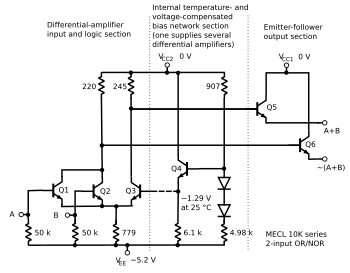
Back منطق الباعث المقرون Arabic Lògica acoblada a emissor Catalan Emittergekoppelte Logik German Emitter-coupled logic Spanish منطق تزویج امیتری FA Emitter coupled logic French Kibocsátókapcsolt logika Hungarian Logika tergandeng–emitor ID Emitter-coupled logic Italian エミッタ結合論理 Japanese

In electronics, emitter-coupled logic (ECL) is a high-speed integrated circuit bipolar transistor logic family. ECL uses an overdriven bipolar junction transistor (BJT) differential amplifier with single-ended input and limited emitter current to avoid the saturated (fully on) region of operation and the resulting slow turn-off behavior.[2] As the current is steered between two legs of an emitter-coupled pair, ECL is sometimes called current-steering logic (CSL),[3] current-mode logic (CML)[4] or current-switch emitter-follower (CSEF) logic.[5]
In ECL, the transistors are never in saturation, the input and output voltages have a small swing (0.8 V), the input impedance is high and the output impedance is low. As a result, the transistors change states quickly, gate delays are low, and the fanout capability is high.[6] In addition, the essentially constant current draw of the differential amplifiers minimizes delays and glitches due to supply-line inductance and capacitance, and the complementary outputs decrease the propagation time of the whole circuit by reducing inverter count.
ECL's major disadvantage is that each gate continuously draws current, which means that it requires (and dissipates) significantly more power than those of other logic families, especially when quiescent.
The equivalent of emitter-coupled logic made from FETs is called source-coupled logic (SCFL).[7]
A variation of ECL in which all signal paths and gate inputs are differential is known as differential current switch (DCS) logic.[8]
- ^ Original drawing based on Blood Jr., William R. (1972). MECL System Design Handbook (PDF) (2nd ed.). Motorola Semiconductor Products. p. 1 – via Bitsavers.
- ^ Lawless, Brian. "Unit4: ECL Emitter Coupled Logic" (PDF). Fundamental Digital Electronics.
- ^ Kumar, Anand (2008). Pulse and Digital Circuits. PHI Learning. p. 472. ISBN 978-81-203-3356-7.
- ^ Stonham, T. J. (1996). Digital Logic Techniques: Principles and Practice. Taylor & Francis. p. 173. ISBN 978-0-412-54970-0.
- ^ Tummala, Rao R. (2001). Fundamentals of Microsystems Packaging. McGraw-Hill. p. 930. ISBN 978-0-07-137169-8.
- ^ Mims, Forrest M. (2000). The Forrest Mims Circuit Scrapbook. Vol. 2. Newnes. p. 115. ISBN 978-1-878707-48-2.
- ^ Fisher, Dennis; Bahl, I.J. (1995). Gallium Arsenide IC Applications Handbook. Vol. 1. Elsevier. p. 61. ISBN 978-0-12-257735-2.
- ^ Eichelberger, E.B.; Bello, S.E. (May 1991). "Differential Current Switch – High performance at low power". IBM Journal of Research and Development. 35 (3): 313–320. doi:10.1147/rd.353.0313.